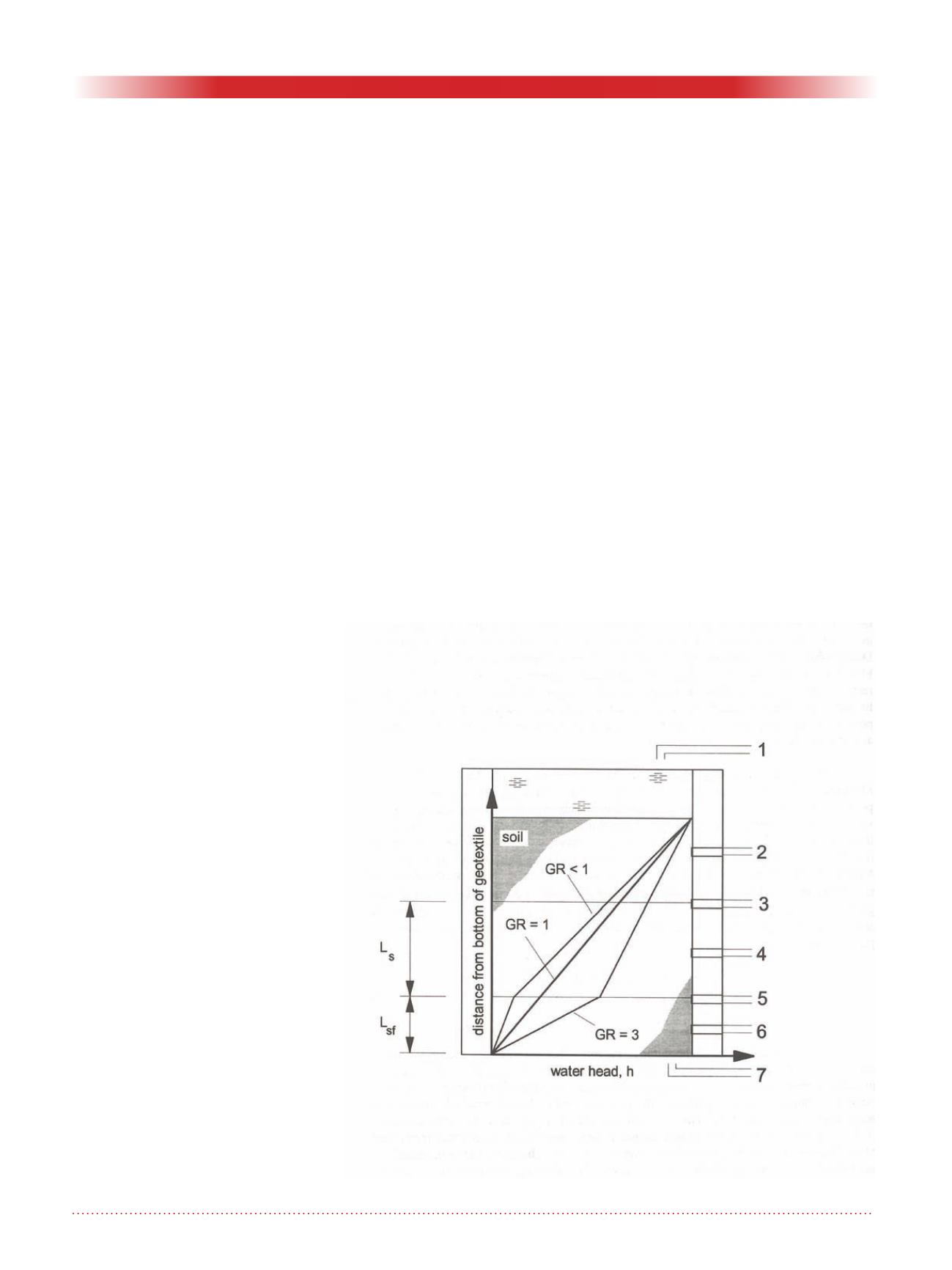
34
Geotechnical News •September 2015
GEOSYNTHETICS
its strength, opening size and permit-
tivity from index testing, and then to
evaluate its suitability from laboratory
compatibility testing. In this article, I
review the origins and some notable
developments in North America that
have informed current practice in the
evaluation of soil-geotextile compat-
ibility.
The early work of the US Army Corps
of Engineers (Calhoun, 1972) on filtra-
tion compatibility included laboratory
permeameter testing to investigate
factors governing soil retention and
permeability. More specifically, the
laboratory filtration tests examined the
ability to retain silty base soils. Two
permeameters were used, a relatively
small one that accommodated a speci-
men 127 mm in diameter and large
one with a diameter of 292 mm. Each
was fitted with a series of manometer
ports on the rigid-wall of the perme-
ameter, at a vertical center-to-center
spacing of 25 mm above the geotex-
tile. The smaller permeameter was
used to evaluate clogging phenomena.
Following placement of the geotextile,
de-aired water was introduced and the
soil then placed underwater using a
tremie-type device, with care taken to
minimize segregation of the grains.
Unidirectional flow was applied in a
downward direction, with the hydrau-
lic gradient controlled by means of a
constant head reservoir. Interpretation
of the results included the reporting
of a ratio of two values of hydraulic
gradient, termed a ‘clogging ratio’
given by i
57
/i
37
(with reference to Fig.
1) The value i
57
is measured across the
lower 25 mm of soil plus the geo-
textile, and the value i
37
is measured
across the lowermost 75 mm of soil
plus the geotextile. A ratio greater
than 1 was considered indicative of
clogging (Calhoun, 1972). Subsequent
work, using the same permeameter
and arrangement of manometer ports
(USACE, 1977), led to the clogging
ratio being replaced by a ‘gradient
ratio’ (GR) that was determined with
reference to i
57
measured across the
lower 25 mm of soil plus the geo-
textile, and i
35
measured across the
adjacent soil a distance 25 mm to 75
mm above the geotextile, yielding:
GR = i
sg
/i
s
where:
i
sg
= hydraulic gradient across the soil-
geotextile composite zone
i
s
= hydraulic gradient in the soil
In principle, ideal compatibility exists
for a gradient ratio = 1 (see Fig. 2). A
value greater than 3 was considered
indicative of ‘excessive clogging’, and
served to quantify the compatibility of
the soil and geotextile.
Haliburton and Wood (1982) used a
permeameter similar to that of Cal-
houn (1972) to evaluate the compara-
tive performance of two nonwoven
and four woven geotextiles. A sand,
and a gap-graded silt-sand (5 % to 80
% silt content), were used in testing.
The soil was reconstituted by a dry
tremied-placement technique, and
then slowly back-flooded from below
with tap water. This represents a minor
variation to the method of speci-
men reconstitution that was used by
Calhoun (1972) and it appears to have
exerted a strong influence on the sub-
sequent standardization of the test in
1992 (as ASTM D 5101). The experi-
mental findings were used to support
the quantifying of excessive clogging
by a gradient ratio value of 3 (from
UASCE, 1977), for which Lafleur et
al. (2002) subsequently proposed an
upper limit of 2 for blinding and lower
limit of 0.5 for piping.
The ASTM recommended specimen
reconstitution technique involves
placement of the soil specimen of
diameter 100 mm and length 100
mm above the geotextile in a dry and
Figure 2. Schematic illustration of the gradient ratio.


